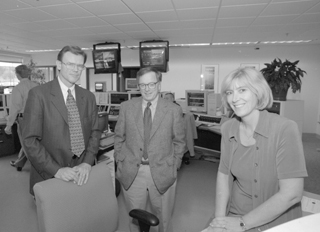The University Record, October 25, 1999 By Judy Dean
Information Technology Division

With scores of academic, administrative and research programs on three campuses, how does an organization as complex as the University prepare for the new millennium? The answer: Through an intense planning and coordination effort that involves nearly every area of the University.
“We have spent months doing Y2K assessments, remediation, testing, and business continuity and contingency planning,” says Jose-Marie Griffiths, university chief information officer and executive director of the Information Technology Division (ITD). “Now it is time to turn our attention to coordinating communications and decision-making associated with the events of the rollover to the year 2000.”
Griffiths heads the committee that has oversight responsibility for making the University’s transition to Y2K as smooth as possible. Other members include Robert Moenart, Financial Operations; Laura Patterson, M-Pathways; Glenna Schweitzer, Office of Budget Administration and Planning; George Cubberly, Risk Management; and Gloria Thiele, Y2K project leader.
“The Regents first asked for an assessment of all campus operations two years ago,” explains Thiele. “Since then, hundreds of individuals have contributed to the body of information we’ve collected in the form of unit-based assessments, status reports and contingency plans. These are the building blocks that will allow us to create an integrated campus response.”
Planning for a coordinated response represents the next big push for U-M’s Y2K planners. Griffiths has called for the creation of a U-M Y2K Response Team to guide the campus through the year-end rollover. Team members will have the task of tracking numerous systems that support campus and Medical Center operations, and making decisions based on pre-established criteria (see sidebar). They also will be responsible for ensuring communications about Y2K-related developments before, during and after the event.
Primary responsibility for setting up and running the Y2K command center will fall to Griffiths and William Bess, director of public safety and security. Several campus units will participate in this activity, including representatives from the Medical Center, ITD, Plant Operations, Housing, Communications and others.
“Although Y2K is unique in some ways, the Department of Public Safety has plenty of experience with respect to command center operations,” Bess says. “We also work closely on a day-to-day basis with city, county and state officials, as well as with our own Plant Department and Medical Center in concert with utility providers and other suppliers.”
Unit representatives and other essential personnel will play an important role during the rollover, serving as liaisons between their respective units and the response team. They’ll be responsible for acting on their units’ contingency plans, if necessary. Each plan describes trigger events, such as a loss of electricity or heat, that would set in motion a series of actions.
William N. Verge, manager, utilities and maintenance engineering, hopes that no contingency plans will need to be activated but agrees that there is no substitute for careful planning. His department has been working for almost two years on a master plan for keeping the University up and running during the rollover. “Every building on campus has been assigned a priority ranking with respect to the mission-critical activities it supports, so if we need to cut back on power or heat, we can do so in an orderly way with minimal disruption. We also have a few portable generators, and plan to have plenty of staff on hand to monitor the situation and troubleshoot any problems that may arise.”
Overall, Griffiths is positive about the University’s Y2K readiness. “We have some final pieces to put in place over the next two months, but the community has accomplished a great deal of what needs to be done. In addition to our campus-based preparations, we have done comprehensive planning to ensure that the University is able to respond to any unexpected external failures associated with the arrival of the year 2000. Our main task now is the creation and implementation of an emergency response system for the rollover, which is in process.”
U-M’s Mission Critical Priorities:
On May 25, 1999, Nancy Cantor, Robert Kasdin and Gilbert Omenn sent a memorandum about U-M Year 2000 issues to executive officers, deans and directors that identified the following priorities for the University, in order of importance:
What can members of the University community do?

